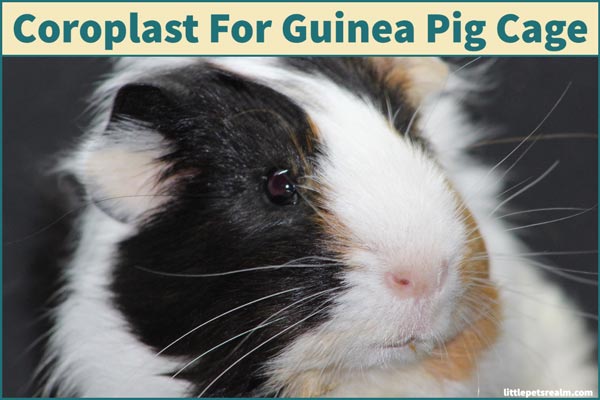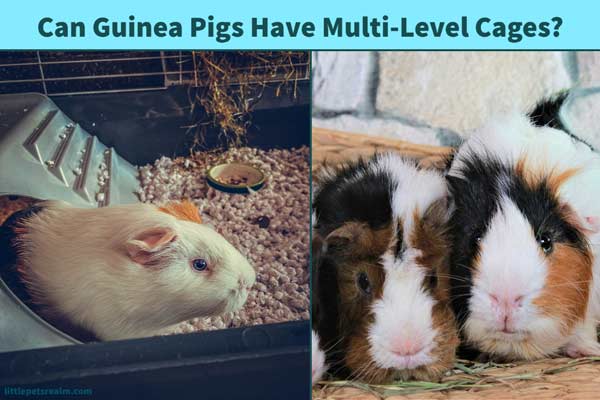When you have guinea pigs, one of your prime concerns must be Controlling moisture. So, you might be finding some Absorbent Materials to control moisture for the guinea pig cage and bedding and keep the cage environment as well as your guinea pig dry.
But, question is, what are the best absorbent materials for a guinea pig’s cage?
There are many different types of absorbent materials available, so it is important to choose the best one for them to prevent cage mess.
In this guide, we will look at some of the best options and discuss their pros and cons to help you make an informed decision.
I will also explain why you should use absorbent materials for the guinea pig cage.
Table of Contents
15 Best absorbent materials for guinea pig cage
Here are the top 15 absorbent materials for guinea pig cages:
1. Natural paper pellets
One of the best absorbent materials is natural paper pellets that can be used in guinea pig cages.
So, if you are looking for absorbent bedding to keep your guinea pig’s cage dry and clean, natural paper bedding is a great option for you.
Natural paper pellets are extremely absorbent and work by quickly absorbing urine from the cage as well as bedding.
Plus, they are also made from natural and biodegradable materials, which helps to keep the cage environment clean and dry.
As they are made from recycled papers and newspapers, they give absorbent property to the materials.
They are also dust-free and hypoallergenic, which makes them ideal for guinea pigs with allergies or respiratory issues.
Moreover, they come at a reasonable price and you may want to have them.
Check out my other article on the best paper beddings for the guinea pigs.
2. Wood shavings
Wood shavings are another popular absorbent material for guinea pig cages.
They are made from wood fibers, which help them to absorb moisture quickly and keep the cage dry.
These shavings are used to make bedding for them.
One of the main advantages of using wood shavings is that they are low in cost, making them an affordable option for many people.
Another advantage is that they are easy to find and can be bought from most pet stores.
However, you can’t use any types of wood shavings for guinea pigs. Avoid cedar or unprocessed pine shavings because they are harmful to their health.
Know about the best wood beddings for guinea pigs.
Aspen shavings
Aspen shaving is a safe and popular absorbent material for guinea pig cages.
They are made from aspen trees, and these trees have a high absorbent rate.
So, when the aspen shavings are used in the cage, they quickly absorb the moisture and keep the cage dry.
Another reason why aspen shavings are good absorbent materials is that they have a fluffy texture, which helps them to absorb moisture very quickly.
Aspen shavings are also biodegradable, which means they are safe for the environment.
They are also inexpensive and easy to find.
That said, there are some drawbacks to using aspen shavings in the cage too.
For example, they can be dusty and cause respiratory problems in some guinea pigs.
So, it is important to choose the right type of aspen shavings and to clean the cage regularly.
Know more about Aspen bedding for guinea pigs.
Kiln-dried pine shavings
Kiln-dried pine shavings are another great absorbent materials you can use in your guinea pig’s cage. It’s used as bedding materials for little pigs.
They are super absorbent because they are made from pine trees.
Kiln-dried pine shavings absorb moisture by drawing it away from your guinea pig’s cage or bedding and into the shavings. This process is called “wicking”.
So, they will help to keep your guinea pig’s cage clean and dry.
Kiln-dried pine shavings are also dust-free, odorless, non-toxic, safe for your guinea pig, and easy to find.
However, all pine shavings aren’t good for their health as they contain aromatic oils.
Make sure that you use Kiln-dried pine shavings that are safe for them.
Check out my other article Kiln-dried pine shavings for guinea pig’s bedding.
3. Fleece
Fleece is one of the most popular absorbent materials for guinea pig cages because it is highly absorbent and can effectively soak up liquids and urine.
This makes it a great choice for guinea pig’s bedding, as it helps to keep the cage clean and dry, and also control odor.
Most fleece is made from polyester and some are made of natural materials.
They are very lightweight and soft, making them comfortable for your guinea pigs to move around on and lay down on.
Fleece is also very easy to clean and can be washed in the washing machine.
Moreover, some fleece (e. g. Guineadad fleece) have anti-microbial, anti-bacterial, and anti-fungal properties.
If you use Guineadad fleece, it can work extremely great for absorbing moisture because its absorbent layer is made with the bamboo blend.
It can also absorb up to 3 times its weight in moisture, which makes it ideal for soaking up urine and other liquids.
In addition, fleece is cost-effective as it’s reusable and washable and you don’t need to replace it often. It’s also durable and dust-free.
Check out my other article on the best fleece bedding for guinea pigs.
4. Newspapers
Newspapers are one of the most absorbent materials that you can use for your guinea pig cage. Moreover, they are cheap, easy to find, and can be easily disposed of when they become soiled.
Newspapers are made from high-quality paper, which allows them to absorb a lot of moisture.
They are also thin and lightweight, which allows them to be folded into many different shapes and sizes.
This makes them a convenient absorbent material to use in your guinea pig cage.
However, you have to keep in mind that you can’t use the newspaper that contains ink.
This is because guinea pigs like to chew on things. Eating newspapers containing ink can cause serious health issues.
You can use them under their bedding to make it more absorbent or use inkless papers.
You can also use inkless shredded paper to increase absorbency.
Check out my other article on how to use shredded newspaper for guinea pig’s bedding.
5. Cotton towels
As cotton towels are highly absorbent and help to keep the cage dry, they are a popular choice for many guinea pig owners
Cotton towels are made from natural cotton fibers, which allows them to soak up a lot of moisture.
They can also be washed and reused over and over again, which makes them a cost-effective option.
They are also thin and lightweight, which makes them easy to use in your guinea pig cage.
You can simply place them under the bedding or on top of the bedding to help absorb any liquids that may be present.
Towels are also safe for your guinea pigs to use, as they are made from natural materials.
Moreover, it’s cheap and readily available.
Learn more about using towels for guinea pigs.
6. Mattress pads
Mattress pads are a great absorbent material to use in your guinea pig cage.
They are made from cotton or polyester, and they are quilted to provide extra absorbency.
They usually have a waterproof backing to prevent leaks, and they can be washed and reused.
Mattress pads are available in various sizes to fit your cage, and they can be cut to fit.
Mattress pads are comfortable for your guinea pig to lie on, and they will help to keep your cage clean and dry.
They are easy to maintain and can be washed and reused as needed, making them a cost-effective choice.
However, they may not be absorbent enough for some types of guinea pig cages, so you may want to consider other options as well.
7. U-haul furniture pads
U-haul furniture pads are a popular choice for my guinea pig’s owner because of their absorbency. These pads are made from cotton or polyester material and are designed to absorb moisture. They are also lightweight and easy to clean.
The pads are available in different sizes, so you can choose one that best fits your guinea pig’s cage.
Many people also use them as bedding, since they are soft and comfortable for the guinea pigs.
You can use it as an absorbent material under bedding such as fleece.
They are also relatively inexpensive.
U-haul furniture pads may not be as durable as some other options.
8. Pee pads
Pee or puppy pads are a common absorbent material for guinea pigs. They are very absorbent and they soak up pee really well.
They are typically made from plastic or cellulose and are non-toxic and safe for your guinea pigs to chew on.
One of the main reasons that pee pads are a good absorbent material for guinea pigs is that they are very effective at absorbing urine.
They can absorb a lot of urine without leaking or becoming saturated.
You can put them in the bottom of the cage or you can put them in a litter box.
As they are absorbent which means they can keep the cage dry and clean.
They are also soft so it won’t hurt the guinea pigs if they accidentally bump into them.
They are also disposable which means you can just throw them away when it gets dirty. A washable pee pad is also available that you can reuse many times.
You can also find them in different colors and designs.
However, they are a bit more expensive than other materials and not as durable as other materials.
They can also be a bit slippery.
Learn more about using puppy pads for guinea pigs.
9. Bath mats
If you are looking for an absorbent material that is easy to clean and provides good traction for your guinea pig’s feet, bath mats are a great option.
They are readily available materials that can be used as bedding or absorbent materials under the bedding in your guinea pig’s cage.
Bath mats are made of different materials, such as rubber or microfiber, which make them absorbent.
They also have a textured surface that helps to keep the cage clean and dry.
Additionally, bath mats are relatively inexpensive, which makes them a cost-effective choice for use as an absorbent material in your guinea pig’s cage.
Bath mats come in a variety of sizes, so you can choose the one that best fits your guinea pig’s cage.
However, there are some drawbacks to using bath mats as an absorbent material for your guinea pig’s cage.
For instance, if your guinea pig likes to chew on things, the rough texture of a bath mat may be uncomfortable for them.
Additionally, some bath mats may have a strong odor that can irritate your guinea pig’s sensitive sense of smell.
Know more about using bath mats for guinea pigs.
10. Zorb fabric
You can also use Zorb fabric as they are good absorbent.
Zorb fabric is made from polyester fibers that are highly absorbent.
The material can be used under the bedding in the cage to absorb any liquids that may be present.
They are also comfortable for your guinea pigs to lie on, and they will help to keep your cage clean and dry.
They are easy to care for and can be washed when it’s required.
Zorb fabric is a good absorbent material, but it is not as durable as some other options and may not be perfect for guinea pigs.
11. Bed linen
Bed linen, such as towels and sheets, can also be used as an absorbent material for your guinea pig’s cage.
This is a cost-effective option, as bed linen is readily available and relatively inexpensive.
It also has a soft texture that can be comfortable for your guinea pigs to lie on.
Additionally, bed linen is easy to care for and can be washed as needed.
However, bed linen is not as durable as some other materials. So, they may not be able to withstand scratches or bites from your guinea pigs.
Additionally, bed linen can be bulky and may not be the best choice if you are trying to keep your guinea pig’s cage as small and minimal as possible.
12. Cotton cloths
Cotton cloths are another versatile option that can be used as an absorbent material in your guinea pig’s cage.
These are readily available and cheap as you can use old cotton clothes.
They are also easy to clean and wash.
Plus, they are soft and comfortable, which will keep your guinea pig happy. However, it’s not an ideal material for guinea pigs.
Moreover, cotton cloths do not have the same absorbency as some other materials, so if your guinea pig tends to be a very messy eater, you may want to consider another option.
13. Hay
Hay is an excellent absorbent material for guinea pig cages and it helps keep the cage clean and dry. It also helps keep the guinea pigs warm and cozy.
Though guinea pigs need plenty of hay as food, you can also use it as bedding material.
As it absorbs moisture, you can use it with other bedding materials.
However, it may not be a good option in the long run.
Know more about using Hay for guinea pig bedding.
14. Blankets
Blankets are a common material used for guinea pig cages. They are soft, comfortable, and relatively easy to clean.
Blankets are great for adding some extra warmth to your guinea pig’s cage, and they also provide a soft surface for your piggies to lay on.
They can also absorb moisture well. However, blankets aren’t good as other options.
They can also be difficult to clean, and they can also harbor bacteria and other potential allergens.
Learn more about using blankets for guinea pigs.
15. Cloth diapers
You can also use cloth diapers as absorbent materials under guinea pig’s bedding.
Cloth diapers are made of layers of fabric, usually cotton, with an absorbent material in the middle, such as microfiber or bamboo.
They are soft and absorbent, and they will not cause any skin irritation since they are made of natural materials.
Plus, you can wash them and reuse them, which makes them a cost-effective choice for your guinea pig’s cage.
However, they are an ideal absorbent material for a guinea pig’s cage and you should choose other options.
Know more about DIY diapers for guinea pigs.
Why should you use absorbent materials in a guinea pig’s cage?
Absorbent materials are an essential part of any guinea pig cage. These materials help to keep the cage clean and dry, which is important for the health of your guinea pig.
Wet and damp conditions are ideal for the growth of bacteria and fungi, which can cause respiratory infections in guinea pigs.
In addition, wet cages can lead to skin irritation, discomfort, and stress.
If you use absorbent materials, it will help prevent all of these conditions because they work by absorbing the urine and moisture from the cage bedding.
This is also helpful to control odor and prevent the foul smell from the cage.
They prevent the build-up of ammonia which can cause respiratory problems in guinea pigs.
Absorbent materials also help to keep your pet healthy and comfortable by better managing the humidity levels inside the cage.
They can help to prevent urine burns and sores on your pet’s feet.
You can also check out my other article on the Best Homemade cleaners for guinea pig cages.
Which absorbent materials should you avoid in a guinea pig’s cage?
You can’t use some absorbent materials for your little pigs. Let’s know about those materials.
Straw
Though straws are a popular option for other pets, they are not ideal absorbent material in guinea pig cages.
This is because straw has hard pointed ends and it may cause harm to your guinea pigs.
Additionally, straw tends to contain mold spores and may also cause an allergic reaction for your guinea pigs.
Therefore, you should avoid using straw as a material to line the bottom of your guinea pigs’ cage.
Cedar Shavings
Cedar shavings are also not a good option for guinea pigs.
This is because cedar shavings are highly toxic for them as it contains dust, phenols, and volatile oils. So, it can cause respiratory problems and even death to your guinea pigs.
Therefore, you should avoid using cedar shavings in your guinea pigs’ cage and instead use safer alternatives such as paper bedding or fleece.
Soft pine shavings
Soft and unprocessed pine shavings are harmful to your guinea pigs as they contain aromatic oils that cause respiratory problems and even it can be life-threatening.
However, you can use kiln-dried pine shavings that are processed nicely to make them free from oils and dust.
Corn husks
Corn husks are a poor choice for guinea pig’s bedding since they are mold-prone. if they eat it, it will cause intestinal blockage.
Most cat litters
You should stay away from most of the cat litters such as clumping, crystal, and clay cat litters.
Clumping cat litter forms a clump and if your guinea pigs eat that, it could cause serious digestion problems and even death. So, you shouldn’t use it.
Things to consider before using absorbent materials for guinea pig
When choosing an absorbent material for your guinea pig cage, there are a few things to consider. Let’s take a look at those.
1. Type of material
The first is the type of material, as different absorbent materials will have different pros and cons. For example, straw or cedar is a good choice for other pets because it is absorbent and also provide insulation. However, they aren’t safe for your guinea pigs.
So, make sure the material is safe for your little pigs.
2. Absorbency
Another thing to consider is the absorbency of the material. You’ll want to choose a material that can absorb urine and other wastes quickly to keep the cage clean and prevent your guinea pigs from coming into contact with their own waste.
You might want to complete the task with whatever you have on hand, such as a coroplast sheet.
For example, coroplast sheets are the best liner for your guinea pig’s cage.
While they are made of durable, waterproof material, they are not very absorbent, which means that they may not be able to effectively absorb urine or liquid from waste.
3. Size of the material
Another thing to consider is the size of the absorbent material. This is important because you need to make sure that the absorbent material is big enough to cover the entire bottom of the cage.
This will help to keep the cage clean and dry, and also prevent your guinea pig from standing on wet bedding.
4. Cost
Another thing to consider is the price of the absorbent material. Absorbent materials can vary in price, so it is important to find one that fits your budget.
However, it is important to remember that the cheapest option is not always the best.
5. Odor control
You’ll also want to consider the odor control of the absorbent material. This is important because some materials can start to smell bad after a while, and you don’t want your guinea pigs to be living in a smelly cage.
Check how to stop the smell from the cage.
6. Ease of clean-up
You also need to consider how easy it is to clean your absorbent material. Some materials can be difficult to wash and rinse, which can make cleaning the cage more of a hassle.
7. Safety
You need to consider the safety of the absorbent material. Some materials can be harmful to your guinea pigs if they ingest them such as climbing cat litter.
So, make sure to choose a safe option for your guinea pigs.
8. Other features
Finally, you should consider any other features that the absorbent material might offer. Some materials can have anti-bacterial properties, which can help to keep your guinea pigs healthy.
Conclusion
Absorbent materials are useful for guinea pig cages to control the moisture, prevent bad odor and keep them and the cage clean.
However, before you choose an absorbent material you have to make sure that it’s safe for them and highly absorbent.
You can get one product above that I mentioned to fulfill your goal.

I am Pallab Kishore, owner of Little Pets Realm. I share important tips, advice and answer all the queries to solve various problems about small pets such as guinea pigs and hamsters on this website.



